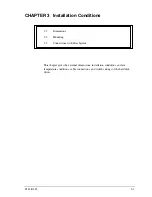
Customizing Your Application 8-5
MN766
Manually Tuning the Control
In some applications the drive cannot be accurately auto-tuned. In these cases it is necessary to calculate the values
needed to tune the drive and manually enter these calculated parameter values.
Current Prop Gain Parameter
This parameter (P1633) is located in the Level 1, Motor Control Block. The Current Prop Gain parameter is normally
autotuned when motor inductance is not known. Where autotuning can’t be used, the proper manual setting for the
proportional gain can be calculated by:
VAC
Where:
L = Line to neutral inductance of the motor in mH
VAC = Nominal line Volts
A/V = The Amps/Volt scaling of the current feedback
Motor line to neutral inductance can be obtained either from the motor manufacturer or by
measuring the line-to-line inductance and dividing by two.
The A/V scaling for the control can be found in the diagnostic information located in the DISPLAY
MODE.
For most applications setting the Current Prop Gain parameter to a value of 60 will yield adequate
performance.
Current PROP Gain
[740 x L x (A/V)]
Current Int Gain Parameter
The Current Int Gain parameter (P1634) located in the Level 1 Motor Control Block is factory preset at 250 Hz. This setting is
suitable for essentially all systems. DO NOT CHANGE WITHOUT FACTORY APPROVAL.
Speed Prop Gain Parameter
The Level 1 Motor Control Block Speed Prop Gain parameter (P1635) factory setting is 1.00. This gain may be increased
or decreased to suit the application. Increasing the Speed Prop Gain parameter will result in faster response, excessive
proportional gain will cause overshoot and ringing. Decreasing the Speed Prop Gain parameter will cause slower response
and decrease overshoot and ringing caused by excessive proportional gain.
Speed Int Gain Parameter
The Level 1 Motor Control Block Speed Int Gain parameter (P1636) is set to 1.00 Hz and may be set at any value from zero
to 50.00 Hz. Setting the Speed Int Gain parameter to 0 Hz removes integral compensation. This results in a proportional loop
only. This selection is ideal for systems where overshoot must be avoided and substantial stiffness (ability of the control to
maintain commanded speed despite varying torque loads) is not required.
Increasing values of the Speed Int Gain parameter increases the low frequency gain and stiffness of the control. An
excessive integral gain setting will cause overshoot for transient speed commands and may lead to oscillation. If the Speed
Prop Gain parameter and the Speed Int Gain parameter are set too high, an overshoot condition can also occur.
To manually tune the control, the following procedure is used:
1. Set the speed Int Gain parameter = 0 (remove integral gain).
2. Increase the Speed Prop Gain parameter setting until adequate response to step speed commands is attained.
3. Increase the Speed Int Gain parameter setting to increase the stiffness of the drive, or ability to maintain speed with
dynamic load changes.
Note:
It is convenient to monitor speed step response with a strip chart recorder or storage oscilloscope connected to
J1-6 or J1-7 with Level 1, Output Block Analog Out1 Signal (P1511) or Analog Out2 Signal (P1514) set to ABS
SPEED, 0 VDC = zero speed. See Chapter 5 for analog outputs.
Summary of Contents for VS1SD
Page 1: ...05 13 Installation Operating Manual MN766 VS1SD AC Servo Control...
Page 12: ...2 2 General Information MN766...
Page 16: ...3 4 Installing the Drive MN766...
Page 108: ...7 34 Parameter Descriptions MN766...
Page 114: ...8 6 Customizing Your Application MN766...
Page 128: ...9 14 Troubleshooting MN766...
Page 154: ...12 12 Monitor and RTC Description MN766...
















































